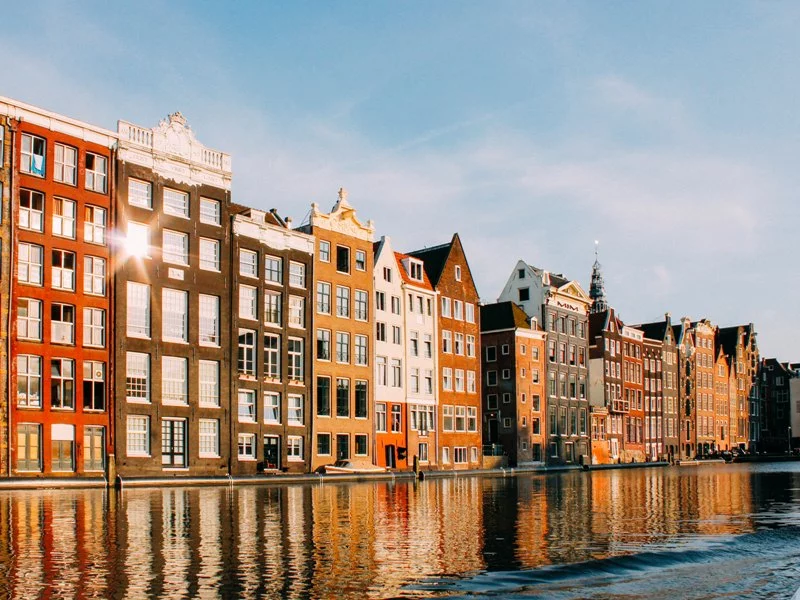Imagine this: It is a crisp autumn morning in Amsterdam, and you are cycling along the picturesque canals. You pass a beautiful 17th-century Dutch townhouse, its windows casting long shadows over the water. Nearby, a newly constructed apartment block, sleek and modern, rises against the skyline. As you continue your ride, the diversity in the city’s architecture becomes clear—a harmonious blend of historic charm and contemporary flair. It is easy to fall in love with the aesthetic, but behind this idyllic scenery lies one of Europe’s most complex and competitive real estate markets.
Marja, a lifelong Amsterdammer, recently sold her 70-square-meter apartment in the trendy De Pijp district. She expected interest, but even she was surprised when her home was sold within a week—at 30% above the asking price. Meanwhile, Chris, an expat who moved to Amsterdam for work, has been searching for an affordable rental for months. Despite a well-paying job in the tech sector, the competition for rental properties is fierce, and rent prices keep climbing.
These stories, though personal, reflect the broader trends that have shaped Amsterdam’s real estate market in recent years—a market characterized by skyrocketing demand, limited supply, and a growing population. In this article, we will explore the factors driving Amsterdam’s real estate boom, examine the key challenges, and look at what the future might hold for buyers, renters, and investors in this vibrant European capital.
The Real Estate Boom in Amsterdam: What is Driving It?
Amsterdam’s real estate market has been upward for nearly a decade. Since the mid-2010s, the city has seen a surge in housing prices attributed to a combination of factors, including population growth, a thriving economy, and a limited housing supply. In 2023, the average price per square meter for homes in Amsterdam was approximately €7,500 (CBS, 2023), a significant increase from €4,400 in 2015.
Population Growth and Urbanization
Amsterdam’s population has grown steadily, with domestic and international migration playing key roles. The city is home to many international companies, making it an attractive location for expats. In 2023, Amsterdam’s population reached 872,000, up from 815,000 in 2015 (Gemeente Amsterdam, 2023). This growth has put significant pressure on housing demand, particularly in central neighborhoods where space is limited.
Supply Constraints and the Historic Nature of the City
Amsterdam’s physical constraints are a crucial factor in the real estate market. With its historic canals, heritage buildings, and a highly regulated planning environment, there is limited scope for new construction in the city center. This has increased the value of existing homes, especially those in Amsterdam’s most desirable areas like Jordaan, Oud-Zuid, and De Pijp.
Even though there are attempts to develop newer housing projects on the city’s periphery, such as the IJburg and Zuidas areas, construction rates have not kept up with the demand. According to the Dutch Central Bureau of Statistics, only 6,000 new homes were built in Amsterdam in 2022 (CBS, 2023). This mismatch between demand and supply has contributed to the increasing property prices.
Interest Rates and Investor Activity
For many years, low interest rates across Europe made borrowing relatively inexpensive, fueling an increase in both domestic and international investment in Amsterdam real estate. Investors, drawn to the city’s stability and attractiveness, saw real estate as a lucrative asset class. According to a 2022 report by JLL, around 20% of property buyers in Amsterdam in recent years have been investors rather than individuals or families looking for a home (JLL, 2022).
The entrance of investors has significantly impacted pricing, especially for rental properties. Large portions of the housing stock in popular districts are now owned by investors, leading to a rental market with higher prices and limited availability for residents.
The Rental Market: A Crisis for Renters
While the sales market has been red-hot, many of the city’s residents feel the most pain in the rental market. Amsterdam has one of the most expensive rental markets in the Netherlands, and rental prices have been steadily climbing. As of 2023, the average rent for a one-bedroom apartment in central Amsterdam was around €1,800 per month (Pararius, 2023), making it one of the most expensive cities in Europe for renters.
Social Housing: An Attempt to Mitigate the Crisis
The Dutch government has long promoted social housing to ensure that lower-income residents have access to affordable living spaces. Amsterdam has historically had a higher percentage of social housing than other European cities. In 2023, around 40% of the city’s housing stock was classified as social housing (Gemeente Amsterdam, 2023).
However, even this system has faced immense pressure. Waiting lists for social housing are long—some individuals can expect to wait more than ten years for a place (Huisvesting, 2023). Additionally, there has been a decline in the availability of social housing units due to sales of these properties to private owners, exacerbating the housing shortage.
Short-Term Rentals and Tourism
Another major challenge for Amsterdam’s rental market has been the rise of short-term rentals, largely fueled by platforms like Airbnb. Although the city has imposed strict regulations on short-term rentals in recent years—including limiting rentals to a maximum of 30 nights per year and requiring registration—tourism continues to impact the availability of long-term housing. In some neighborhoods, the prevalence of short-term rentals has driven up prices and reduced the number of apartments available to permanent residents.
Government Policies and Regulatory Challenges
Recognizing the challenges of an overheated real estate market, Amsterdam’s government has introduced several policies to cool the market and make housing more accessible.
Rent Controls and New Regulations
In 2023, the Dutch government expanded its rent control policies, capping rental prices for newly built properties in certain areas to prevent excessive price hikes (Rijksoverheid, 2023). Additionally, stricter rules were implemented to regulate Airbnb and other short-term rental platforms. These policies are intended to ease pressure on the rental market, but whether they will significantly impact prices or availability remains to be seen.
Restrictions on Foreign Investors
As of 2022, Amsterdam also introduced policies to limit the influence of foreign investors. In some districts, property purchases by non-EU citizens were restricted to prevent price inflation driven by international buyers. This policy is still relatively new, so its long-term effects are not fully understood.
The Future of Amsterdam Real Estate: What is Next?
Despite the challenges, Amsterdam’s real estate market is expected to remain strong, driven by demand from both residents and international investors. However, many experts believe the city must focus on long-term solutions to create more affordable housing options.
Increased Construction on the Outskirts
The city has expanded into new areas to alleviate pressure on the housing market, particularly in neighborhoods like Zeeburgereiland and Sloterdijk. The goal is to create modern, high-density housing that can accommodate the growing population without compromising the city’s historic character.
Sustainability in Real Estate Development
Sustainability is becoming a growing focus in Amsterdam’s real estate sector. The city aims to become fully carbon-neutral by 2050, and new construction projects are being designed with this goal in mind. The Zuidas district, for example, is incorporating green building techniques, energy-efficient designs, and sustainable transport options to create a more eco-friendly urban environment.
Conclusion
The Amsterdam real estate market is a microcosm of global cities’ challenges with rapidly growing populations and limited space. While the market thrives, the rising costs and limited housing options highlight the need for long-term solutions that balance demand with sustainability. Whether you are a buyer, renter, or investor, the key to navigating Amsterdam’s real estate landscape lies in understanding the intricate web of factors that shape this vibrant city’s housing market.














